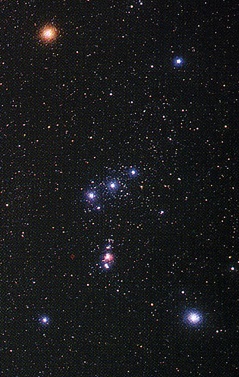 The two stars on the edge of the dipper closest to this writing are pointer
stars. They point directly to Polaris, which is on the tail of Ursa minor.
The two stars on the edge of the dipper closest to this writing are pointer
stars. They point directly to Polaris, which is on the tail of Ursa minor.
Stars are what interest me most in astronomy. I love just going out at
night and staring at them. A few years ago, my boyfriend and I went out into
the backwoods for a couple of hours to take a photo of the stars as they
moved across the background sky. The exposure was about forty minutes, and
the results weren't fabulous, but they were inspiring... read on.
My favorite Constellations
Ursa Major- The big bear in the sky. In my part of the world he is always visible. The picture below isn't a complete view of Ursa Major, but only a part of him, the most visible part, the Big Dipper. Ursa Major is actually far larger than this one section. You can only really see all of him if you're out in the back woods.
Ursa major is actually made up of 8 stars, not seven. The middle star on the handle is actually a binary system of one large star and a smaller star. Most stars in the universe are binary.
 The two stars on the edge of the dipper closest to this writing are pointer
stars. They point directly to Polaris, which is on the tail of Ursa minor.
The two stars on the edge of the dipper closest to this writing are pointer
stars. They point directly to Polaris, which is on the tail of Ursa minor.
Cassiopeia- She's one of the neatest constellations. Like cygnus (the swan) she lies (or sits) along the milky way- the edge of our galaxy-. She's supposed to be a woman on a throne, but I can never quite see that in her.
 Cassiopeia, the great W in the sky.
Cassiopeia, the great W in the sky.
In mythology, Cassiopeia was queen of Aethiopia and mother of Andromeda (who coincidentally has the M 31 galaxy (located just beneath the second lower point of the w) named after her). As the story goes, the Romans weren't too happy with her boastfulness and chained her to her throne. This is why sometimes her constellation is seen to hang upside down.
Orion- Okay, so everyone and their dog is also familiar with this next one. But, apart from his belt, there are are several very interesting things about Orion. One is the Orion nebula, located on the sword. I'll go into this in greater detail later. The other is the two major stars on him. One is Betelgeuse and the other is rigel, located at opposite ends of his body (B on the top left and R on the bottom right). Rigel means foot, and it is an extremely bright star. Rigel is a Blue star (VERY HOT), and betelgeuse is a Red Giant, a cool slow burning star.
 this image clearly shows Betelgeuse at the upper left, Rigel on the lower
right, and the orion nebula
this image clearly shows Betelgeuse at the upper left, Rigel on the lower
right, and the orion nebula
In mythology Orion has always been a constellation of great importance.
Even the egyptians named it Sahu, the soul of Osiris. In Greek mythology,
Artemis had fallen in love with Orion, but her brother Apollo had tricked
her into shooting him with her bow. When she realized her mistake, she placed
his body in the sky. (i assume she had this ability because she is the moon
goddess)
Star Clusters
There are three major types of star clusters:
Open star clusters- One of the most prominent examples is the pleiades,
the seven sisters-- also known as subaru (like the
company)
 the pleiades.. they're really small, but you can find them (looking
like a little big dipper) up and to the right of Orion, just a little higher
is an even smaller open cluster known as the Heides.
the pleiades.. they're really small, but you can find them (looking
like a little big dipper) up and to the right of Orion, just a little higher
is an even smaller open cluster known as the Heides.
Stellar Associations- like open clusters, but a lot bigger.
Globular Clusters- These are the neatest ones. They're HUGE, i mean, big.
Think 2 million stars all rotating around each other.
They're usually located around the center of the galaxy.